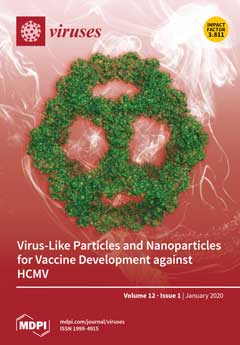Virus attachment and entry is a complex interplay of viral and cellular interaction partners. Employing bovine viral diarrhea virus (BVDV) encoding an mCherry-E2 fusion protein (BVDV
E2-mCherry), being the first genetically labelled member of the family
Flaviviridae applicable for the analysis of
[...] Read more.
Virus attachment and entry is a complex interplay of viral and cellular interaction partners. Employing bovine viral diarrhea virus (BVDV) encoding an mCherry-E2 fusion protein (BVDV
E2-mCherry), being the first genetically labelled member of the family
Flaviviridae applicable for the analysis of virus particles, the early events of infection—attachment, particle surface transport, and endocytosis—were monitored to better understand the mechanisms underlying virus entry and their dependence on the virus receptor, bovine CD46. The analysis of 801 tracks on the surface of SK6 cells inducibly expressing fluorophore labelled bovine CD46 (CD46
fluo) demonstrated the presence of directed, diffusive, and confined motion. 26 entry events could be identified, with the majority being associated with a CD46
fluo positive structure during endocytosis and occurring more than 20 min after virus addition. Deletion of the CD46
fluo E2 binding domain (CD46
fluo∆E2bind) did not affect the types of motions observed on the cell surface but resulted in a decreased number of observable entry events (2 out of 1081 tracks). Mean squared displacement analysis revealed a significantly increased velocity of particle transport for directed motions on CD46
fluo∆E2bind expressing cells in comparison to CD46
fluo. These results indicate that the presence of bovine CD46 is only affecting the speed of directed transport, but otherwise not influencing BVDV cell surface motility. Instead, bovine CD46 seems to be an important factor during uptake, suggesting the presence of additional cellular proteins interacting with the virus which are able to support its transport on the virus surface.
Full article






